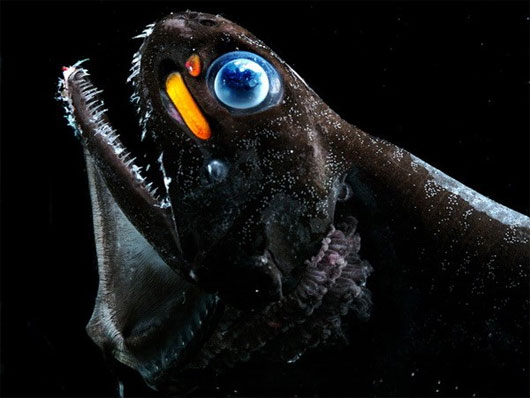How did arowanas evolve to emit red light?
Arowanas are frightening creatures, living in dark waters of the bottom of the variable. Their habitats discourage the use of eyes to see or the ability to see colors. However, some arowana species evolve very quickly: they turn from sensitive to blue light to sensitive to red light.
This is a strange thing because the sea floor is not the place where such evolution takes place.'The bottom is always dark and nothing changes. There must be something else down there that causes this visual evolution, " Christopher Kenaley, a Harvard University biologist, told Live Science.
The cause of this evolution is likely to be the bioluminescent bioluminescence of arowanas as well as other benthic creatures.
Arowanas have much larger jaws and teeth than the body, live at a depth of 200-2000m above sea level. About 95% of organisms in this depth can see blue light, and also have bioluminescence.
They glow to lure the prey to, communicate with each other or disguise in the dim light from the surface of the sea. Some species such as bearded fish also have blue glowing muscle fibers.

Arowanas can switch from sensitive to light blue to sensitive to red light.(Source: livescience.com)
Although blue is the default color for the sea, 9 species of arowana are visible and glow in red.
To reconstruct the evolutionary history of arowanas, the researchers looked at the differences in programmed gene sequences so rhodopsin - light-sensitive pigment as well as three other genes in samples from 23 fish groups dragon. To confirm when the arowana groups separated from each other during evolution, the researchers also used the estimated lifespan of fossil samples.
They concluded that the arowana's red-vision ability evolved about 15 million years ago . Species that see red light are able to emit this light with long wavelengths. To emit light, they use light-emitting organs located in front of the eyeballs. Red light cannot lure prey because most of them don't see it, but it allows the arowana to easily see their prey.
About 4 million years ago, some species of fish saw red and moved back to see blue. The team's analysis suggests that two groups of modern fish that are able to see blue have ancestors capable of seeing red.
'We now understand that visual evolution can happen very quickly in an environment without much change,' Kenaley said.
Bioluminescence is thought to be the cause of this visual change. These organisms have an enzyme called coelenterazine . Used by vertebrates to neutralize free radicals, this enzyme produces photons or light molecules. After being filtered through glowing organ tissue, the light produced is blue. Compared to other colored light, blue light goes deeper into the seabed, so creatures living deep in the sea are able to see this light.
Arowanas have changed the process to emit red light, and this evolution has led to the ability to see red light.
This study provided the opposite view of previous studies of the possibility of seeing red light evolved at least twice separately. Meanwhile, other genetic studies that divide fish species capable of seeing blue and red light into two different groups have yet to give any evidence of an ancestral species seeing red light. Go back to see the blue light.
- Human hands emit light
- Cats emit blue light thanks to genetic modification
- Glow for ... to be eaten
- Things you don't know about arowana
- 4 mistake that ancient scientists believe
- What is special about arowana?
- The fight between sharks and arowanas
- Scientists measure the total amount of light produced in the universe
- Deep sea monster with strange sharp teeth throughout
- Vietnam used to exist rare arowanas?
- Electronic books emit light
- Fluttering UFOs in America
 Surprised: Fish that live in the dark ocean still see colors
Surprised: Fish that live in the dark ocean still see colors Japan suddenly caught the creature that caused the earthquake in the legend
Japan suddenly caught the creature that caused the earthquake in the legend A series of gray whale carcasses washed ashore on California's coast
A series of gray whale carcasses washed ashore on California's coast Compare the size of shark species in the world
Compare the size of shark species in the world